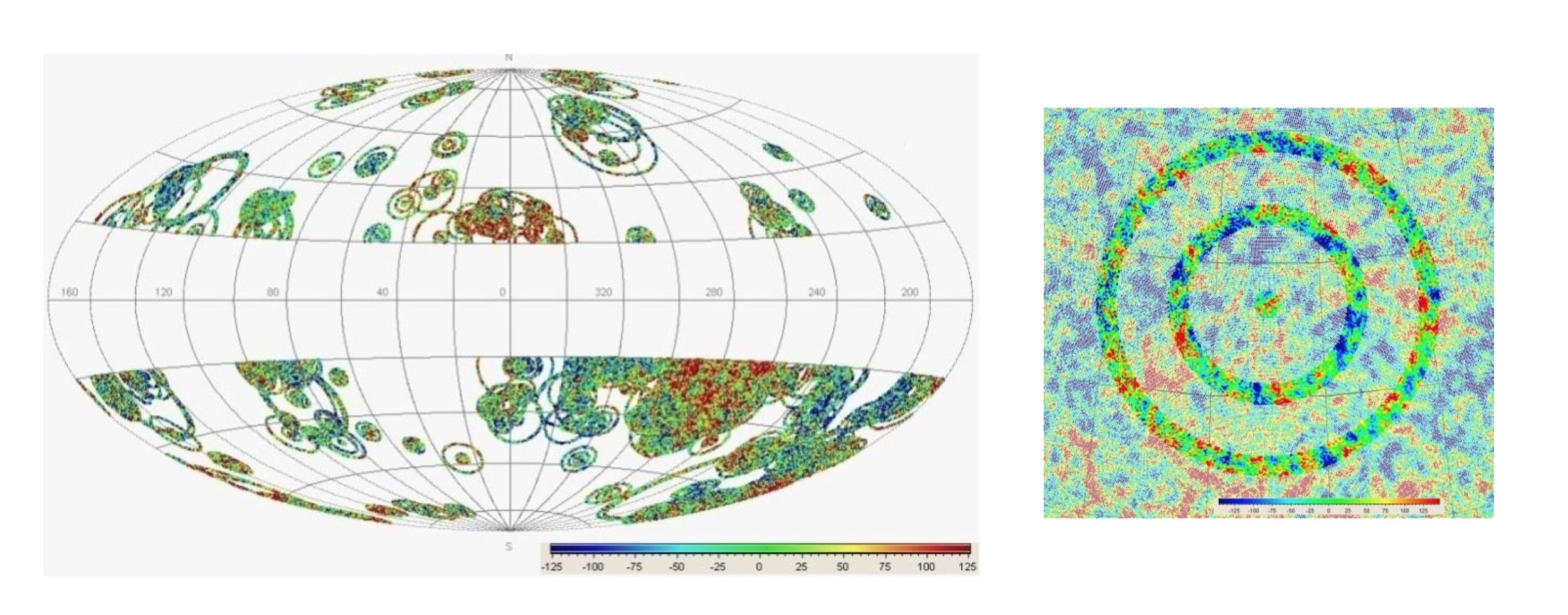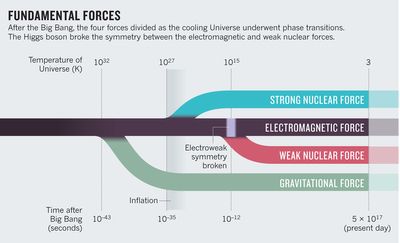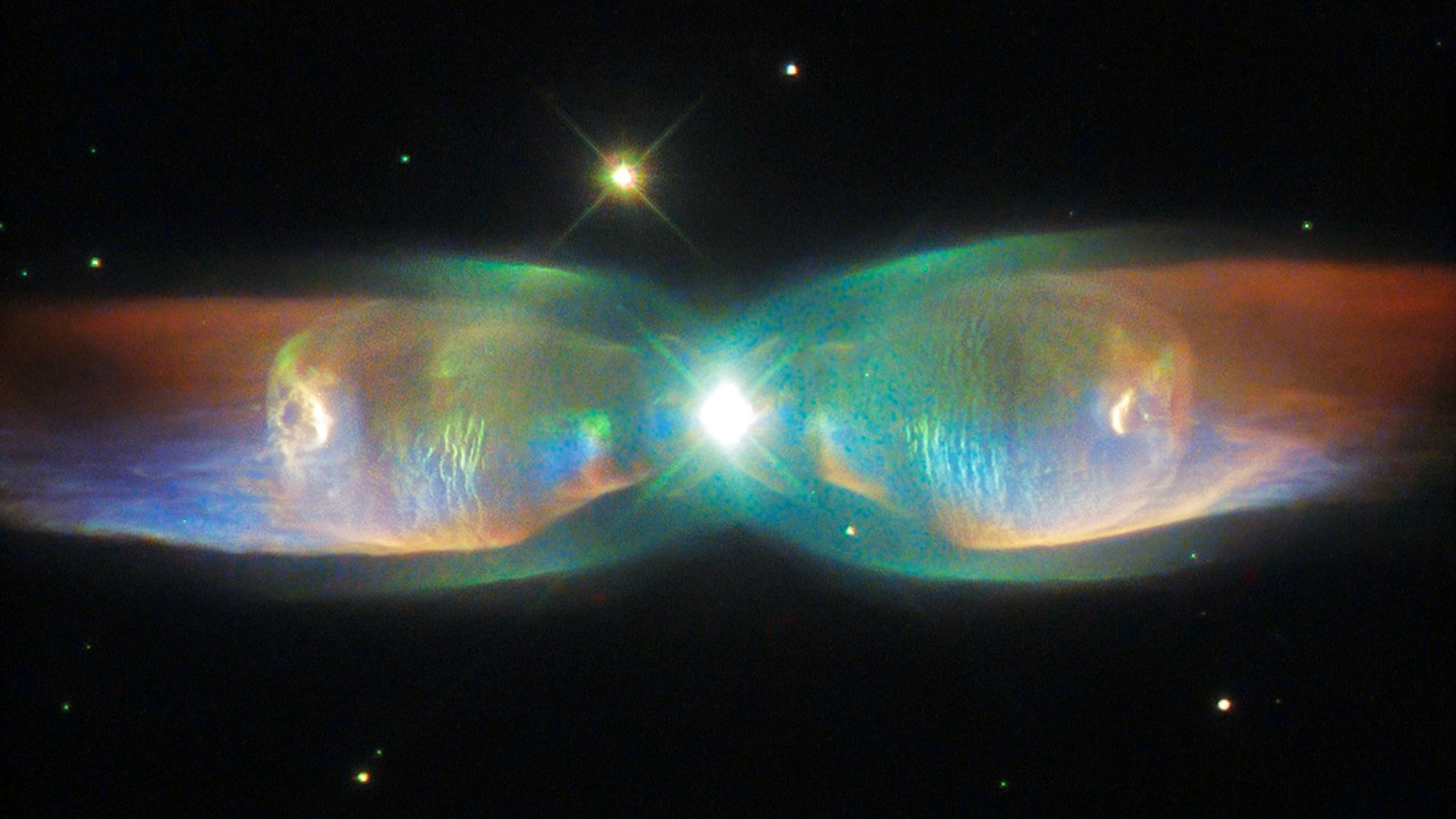In presenting the illustrations for this chapter I show a new and very significant result in talking about the pattern of rotation. This new illustration works to show the relationship between the preferred rotation of galaxies and the quadrupole map from WMAP.
If the cosmological principle that underlies our universe is indeed fractal geometry then there must exist a dynamic self-similar pattern that is to be found at any scale. It is to be found in the shapes of active quasar galaxies and in the supernova of stars. But in turn, at the quantum scale, it is to be found in the orbits of electrons around their respective atomic nuclei. [1]
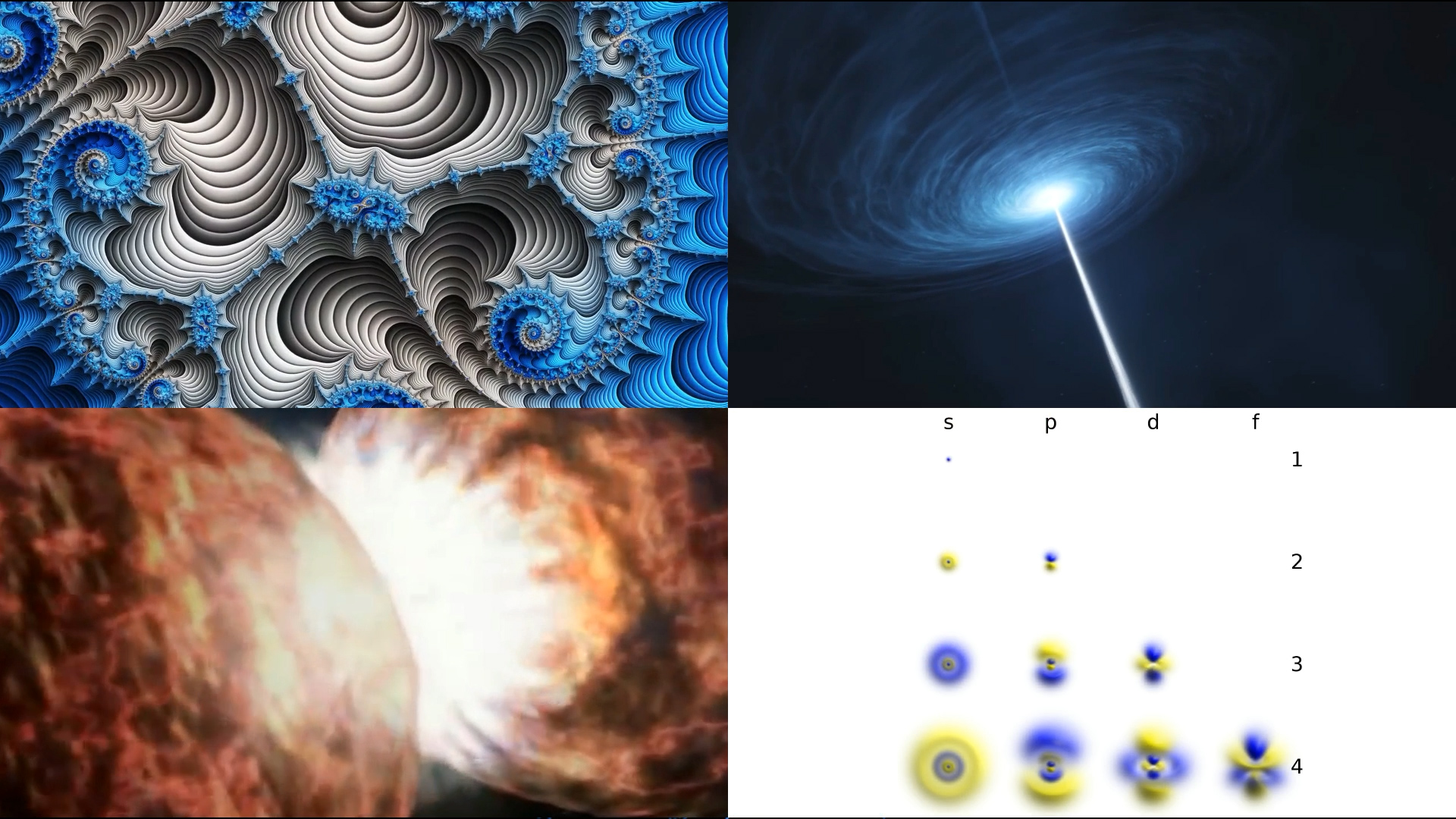
Top-left, the Mandelbrot fractal. Top-right, at the large scale, artistic depiction of an active galaxy. Bottom-left, at the next scale down, artistic depiction of a supernova explosion. Bottom-right, at the next scale down, atomic orbitals of the electron in a hydrogen atom.
As a start into this exploration let us first try and sketch the outline of its most basic shape by looking at the pattern formed by a black hole that is actively feeding. In turn I’ll try to describe the general behaviour of this possible self-similar dynamic pattern in terms of both input and output from its system. [2]
The event horizon of a black hole defines the point of no return beyond which there is no escape. The gravitational pull of the black hole beyond the event horizon is so strong that even light itself cannot escape. This spherical event horizon of the black hole takes centre place in my picture of this self-similar pattern.
Physicists talk about there being two types of black holes; non-rotating black holes and rotating black holes. Discussions of non-rotating, or Schwarzschild, black holes are much simpler as the mathematics is easier when compared to the mathematics of rotating, or Kerr black holes. However we are primarily interested in rotating Kerr black holes as this defines a rotational motion around a given axis and this is a very critical point in my description.
It is critical for three main reasons. Firstly, the hypernova of a massive star gives birth to a rotating black hole. Secondly, as I will show in the next sections, the few galaxies in the Bootes supervoid are to be found in a roughly tube-shaped region running through the middle of the void. This as I will argue is the axis of rotation for as yet an undefined type of starlike object whose nova gives birth to creation as we know it. Thirdly, the ring shaped singularity of the Kerr black hole theoretically can form the mouth of a wormhole.
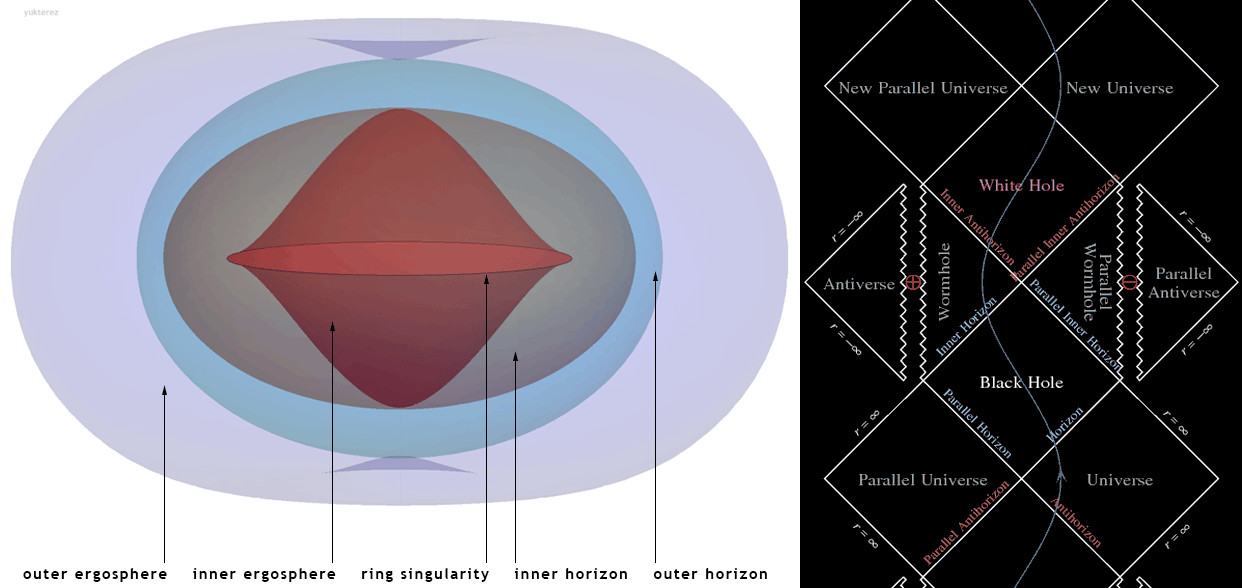
Left, event horizons and ergospheres of a rotating black hole; the ring singularity is located at the equatorial kink of the inner ergosphere. Right, a maximally extended Penrose diagram showing the wormhole connection between the black and white holes. This connection to a white hole and its birth gives the Big Bang Hypernova Hypothesis the exact reason for why our universe, along with our parallel twin (also depicted in the maximally extended Penrose diagram), was born into existence. [3]
This last point that a Kerr black hole is one end of a wormhole may sound very academic. But to me all I see is the total future of humanity. For in this one detail the future of all intelligent self-aware species that dream of interstellar space travel is written. Particularly, when you understand how to create an artificial particle through the applied use of liquid helium and gyroscopes. But before we get there we have to gain an understanding of this self-similar pattern and rotation plays a central role as it is in everything from high to low. [4]
Galaxies rotate around a central core. Our own sun travels through the milky way galaxy orbiting around its central core. One orbit of the sun around the galaxy takes around 240 million years, the length of a cosmic year. Earth, and all the other planets in the solar system orbit the sun. Both the sun and the planets in turn rotate upon an axis of rotation giving us night and day.
And then there is quantum mechanics where particles are described as having spin. Spin the quantum mechanical version of angular momentum is in all the particles, except the Higgs Boson, and as we shall see there is a very clear and beautiful reason for why this is the case.

At the very largest scale of the entire universe rotation plays a critical role which is illustrated in the two quadrupole maps. The map on the left shows the quadrupole map of the Cosmic Microwave Sky as taken from WMAP. The map on the right is the quadrupole map showing the statistical significance of preferred direction of rotation (either clockwise or anticlockwise) of galaxies. [5] [6] [7]
Thus for our self-repeating pattern we define an axis running through the centre of the sphere around which it rotates. The intersection between this axis of rotation and the surface of the sphere defines the locations of both the north and south poles upon our sphere.
Additionally, given the location of the poles upon the sphere, we can define the equatorial plane. The equatorial plane bisects the sphere into two equal haves where the poles are at the top of the two subsequent hemispheres. The line defined by the intersection between the sphere and the equatorial plane is the equator.
With the equatorial plane defined we now look to define the input into this system. In thinking about a black hole this input comes from the matter that falls in towards the black hole. The orbital mechanics and non-linear dynamics, brought about by gravitational and electro-magnetic forces, acting on one another are extremely complex. However a general pattern emerges as the chaotic system approaches some form of equilibrium and that is in the formation of an accretion disk of dust and matter lying on the equatorial plane.
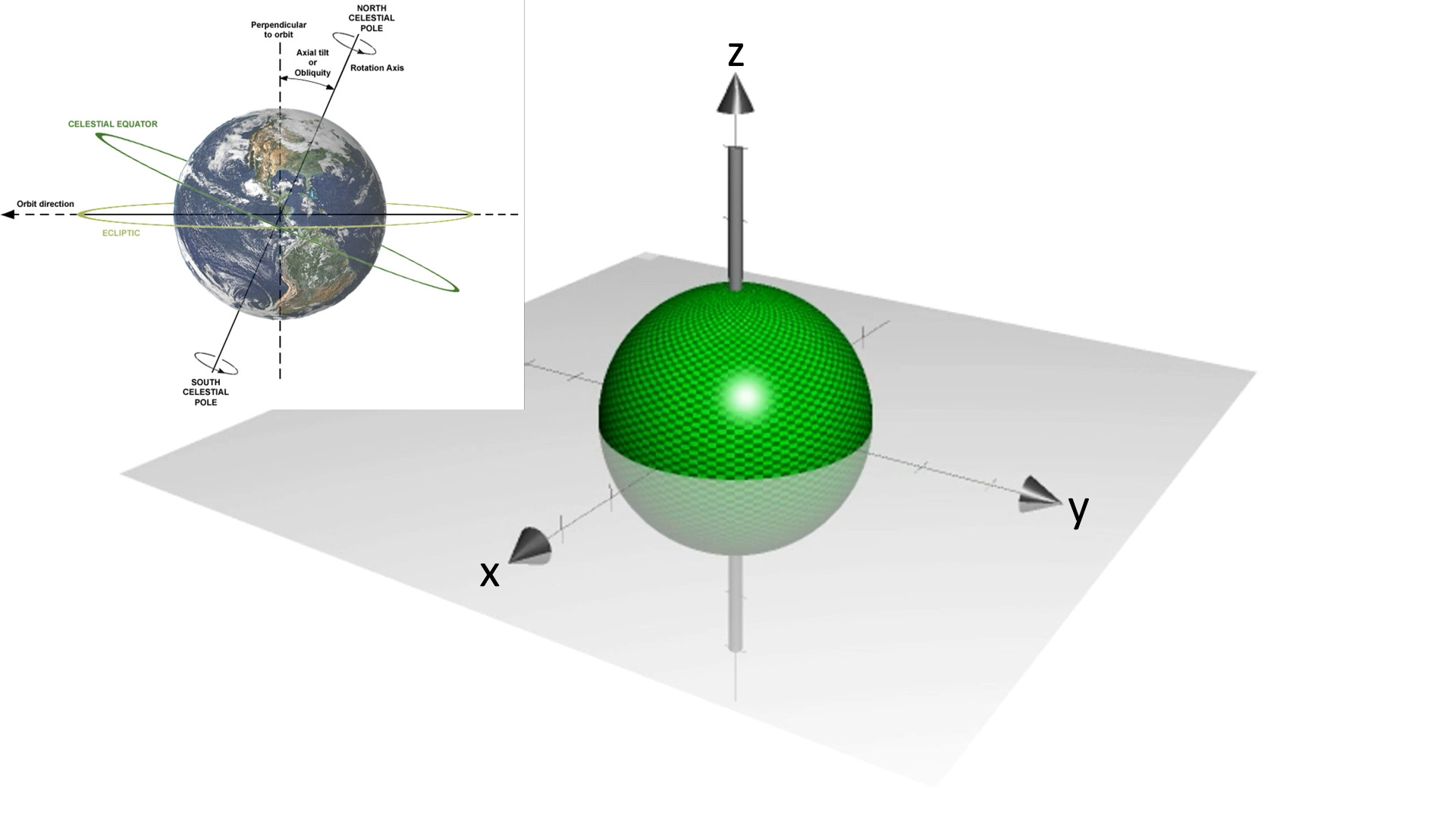
We define a sphere and a frame of reference. The origin point for our frame of reference is located at the centre of the sphere. We define the equatorial plane as the xy-plane which bisects the sphere. Where the sphere is bisected by the equatorial plane we define this to be the equator of the sphere. The z-axis defines the geographical poles. The north pole is the upper or positive part of the z-axis and vice versa for the south pole.
Accretion disks are formed from diffuse material following an orbital path around a massive central body. Our own solar system is believed to have formed from such a disc of dust when our sun was born. Another such massive central body is a rotating black hole. In fact, on the next scale up, an entire spiral galaxy can be viewed as the accretion disk of the supermassive black hole located at their centre. [1] [8]
So for my picture of a self-similar pattern I define the input area from the accretion disc by drawing a donut shaped torus that encircles the central sphere. This torus itself lies on the equatorial plane. Although, as I said, the input orbital mechanics are extremely complex I wish to discuss two mathematical modelling results that cause to me define it as such.
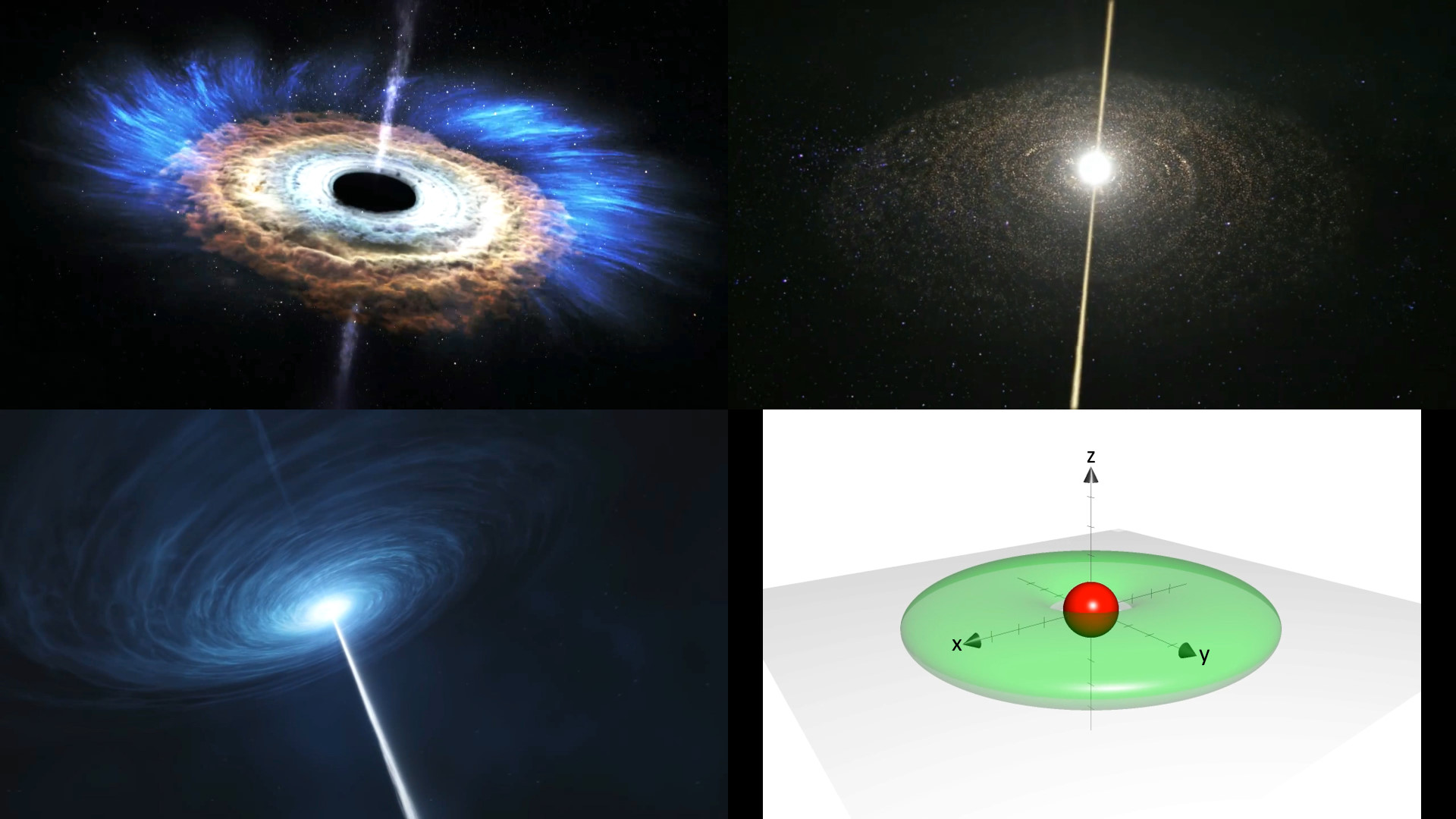
Top-left accretion disc around a black hole. Top-right a protoplanetary accretion disc around a new born star. Bottom-left galactic accretion disc around its supermassive black hole. Bottom-right the torus shaped accretion disc that surrounds the sphere in abstraction of the pattern we wish to identify.
The first, taken from Wikipedia’s page for rotating black holes, shows the orbit of a single particle around a Kerr black hole. The path of the particle that is in a prograde orbit around the rotating black hole, as you can see, traces the outline of a torus. [9]
The second mathematical model considers the evolution of an accretion disc around a rotating black hole whose initial plane lies at 120 degrees offset from the equatorial plane. This . Here the original disc is broken up such that a new donut shaped accretion disc is formed, close to the rotating black hole, that lies upon the equatorial plane. [10]
A particle that falls in towards the black hole is either swallowed by the black hole never to return or is ejected up and away from one of the two poles following the axis of rotation. Collectively this material gives rise to the formation of two astrophysical jets. Again, like the formation of accretion discs, the non-linear dynamics invoked in the formation of the two astrophysical jets is extremely complex. But always the same general pattern emerges in that the output is in the form of two high energy jets, travelling close to the speed of light, ejected from both poles. [11] [12]
There are two paths a particle can take when travelling along the sphere’s axis of rotation. The first path is directly along the axis of rotation. Here the particle travels away from the sphere in a straight line that is defined by the axis of rotation.
The overall direction of travel of the second path is again along the straight line in the same direction. But rather than it being exactly on the line, that is the axis of rotation, it orbits the line. That is, the ascribed path forms a helix spiral such that the particle orbits the line of rotation as it travels along it.
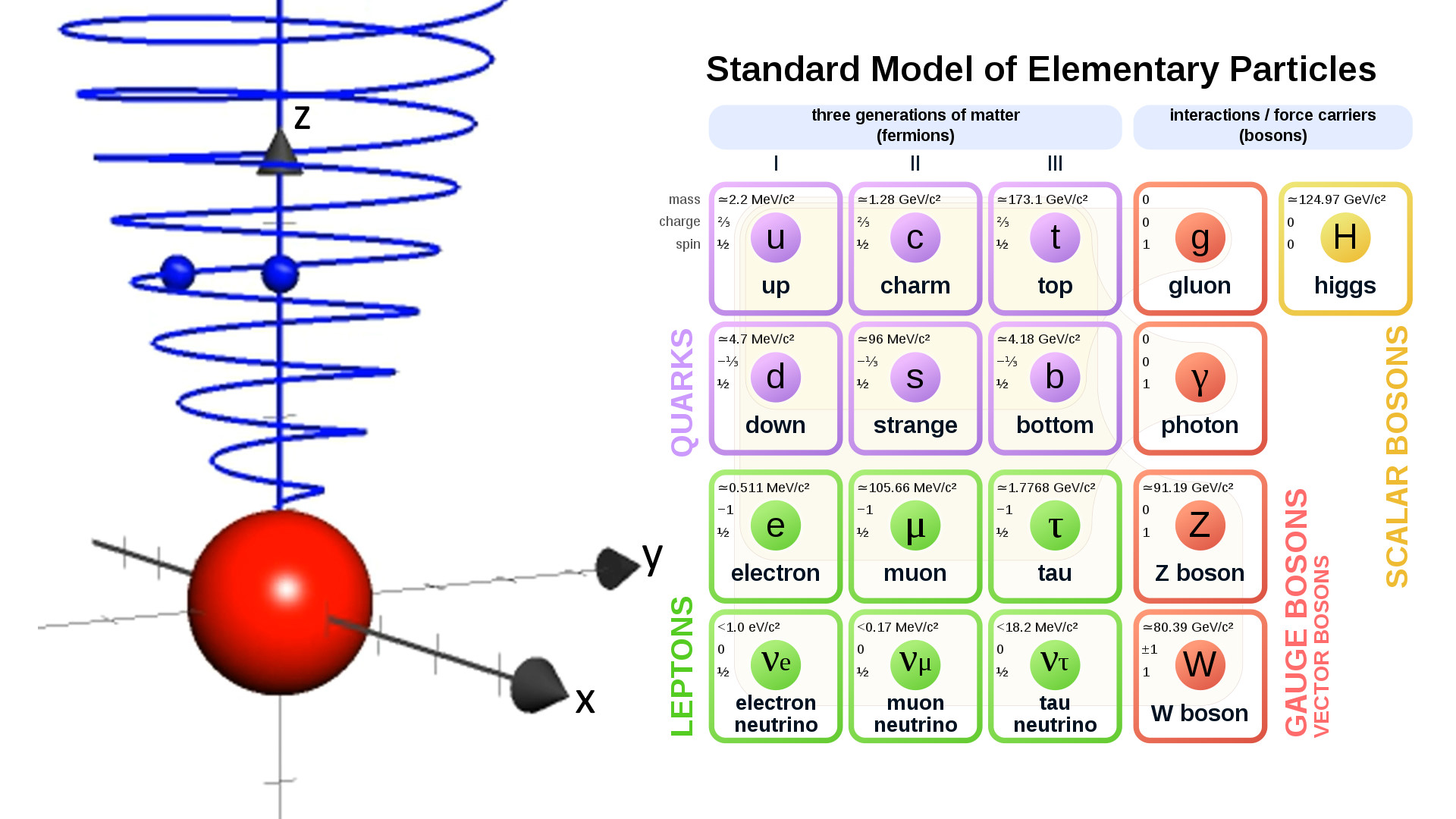
Left, the two escape paths following the z-axis. Right, the standard model of elementary particles. With the exception of the Higgs Boson all the other particles have a positive spin value; whereas the Higgs Boson has a spin of zero. So the basic idea is that the Higgs Boson travels directly along the z-axis. Conversely, all the other particles follow a helical path around the z-axis.
With these two paths defined, I can begin to give insight into why all the particles with the exception of the Higgs boson has a defined quantity for spin. The standard model of particle physics splits matter into two different types; fermions with spin equal to a half and the force boson particles whose spin is equal to one. The exception to all of this is the Higgs boson with a spin equal to zero.
Commonly described as being the particle responsible for giving everything mass the Higgs boson is the particle representation of the Higgs field. The Higgs field in turn is described as being omnipresent through out the universe existing in all locations. Nicknamed “The God Particle” because it is omnipresent, in all things, without it matter would not have mass and hence weight. Although the details are much more complicated; this does as a very good description of what the Higgs field does along with the particle representation of this field.
Let us now reconsider the two paths that a particle can take when travelling along the axis of rotation. One unique path is on the straight line that is defined as the axis of rotation. The second path is not unique and is defined as the orbital helical spiral following the axis of rotation. It is not unique because multiple helical orbits can be defined by varying the radial distance of its orbit around the axis of rotation. If the radial distance is equal to zero then the helical orbital path is in fact the unique path that is the straight line that is the axis of rotation.
Roger Penrose and colleagues identified a concentric ring pattern in the Cosmic Microwave Background Radiation. This concentric ring pattern has been identified as being echoed again and again coming from all directions of the sky. My interpretation is that this is the unfolding of the jet, that is our verse, into a concentric ringed structure. [13] [14] [15]
Such a concentric ring pattern is seen forming in this relativistic hydrodynamic simulation by the university of Amsterdam which models a feeding black hole. On a personal note, I would have loved to have been the coder that did the GPU code for this model. [10]
The formation of an input accretion disc feeds a black hole whose output is a pair of astrophysical jets each with a concentric ringed shaped structure. The black hole born, in the heart of a hypernova, produces this dynamic pattern of behaviour. The video shown is a MHD General Relativistic simulation by the University of Amsterdam and Berkley. This concentric ringed imprint is to be found on the Microwave Sky as identified by Roger Penrose. [10][13]
Commonly called the holy grail of physics a working theory that looks to unify the four fundamental forces is the main area of research for particle physicists. Einstein, in his later life, tried to answer this very question without success of how to unify the four fundamental forces of nature.
In my model it is the breaking of the jet into a series of concentric rings. The outer ring of matter gives rise to leptons, the inner ring the quarks and lastly there is a central dot that follows the axis of the jet’s rotation. Here in the middle of all is the omnipresent Higgs field that has zero angular momentum, or spin, about the axis of rotation. In fact it is the very physical manifestation that is the axis of rotation about which everything else rotates.
Particle animation of model that shows the individual particles as bubbles in a liquid medium. You can download the Blender model file by clicking this link.
And if your wondering how each of these concentric rings could be the matter from which all particles are given form then that is a discussion for later on. Suffice to say that it is a discussion and description given voice by quantum field theory, the most accurate scientific theory that we as humans currently have. Or as John Wheeler postulated to Richard Feynman in the spring of 1940 that there was only one electron in the universe. John Wheeler postulated that there was in fact one electron in the universe, having the same behaviour, because electrons are in fact part of the same whole mass. In my model, these fields have a relatively imaginary depth and particles the tips of icebergs upon these fields.
But for the moment, with respect to the discussion regarding the shape of this universal self-similar pattern, I wish to describe the overall shape that for us forms the basis of quantum fields. The first and only unique shape is the one that is travelling along the line, away from a given pole, that is the axis of rotation. The second are various helical spiral orbits whose path lies on either a conic or parabolic surface.
Wither the defined surface is conic or parabolic, or in fact hyperbolic, is still an enigma to me. The mathematics of quantum field theory holds the key. But as I said my idea is young and the brush strokes coarse and ever evolving. What matters is that they form a shape that gives rise to a pair of jets travelling away from the central sphere along its axis of rotation.
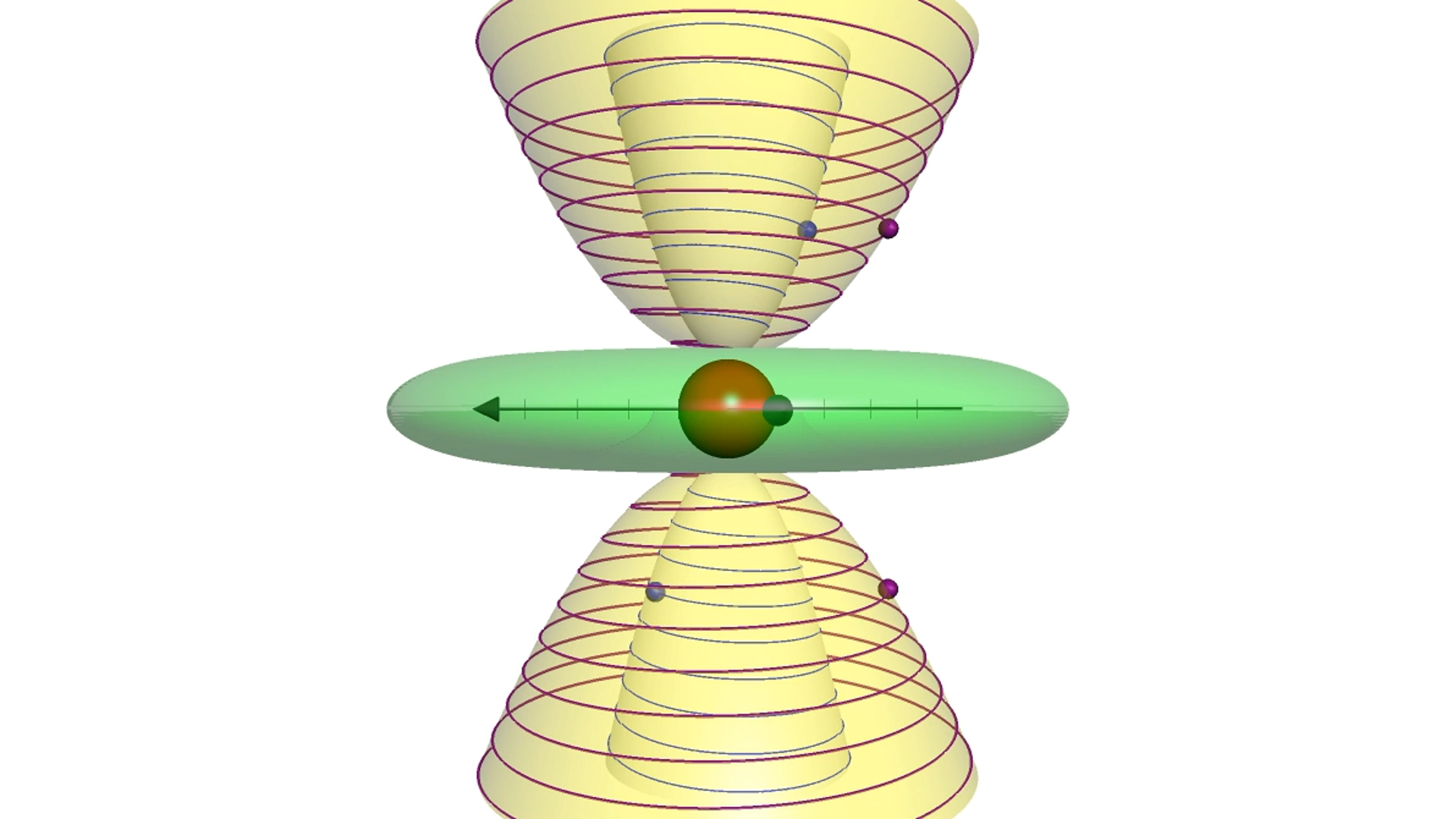
With the description complete we can see a sphere surrounded by a torus shaped accretion disc that is the input into the system. Orthogonal to this is the axis of rotation around which a series concentric ringed jets are shaped by the non-unique helical escape paths that form the output from the system. In addition there is also the unique helical escape path that lies on the axis of rotation itself.
Stepping back we can see the rough shape and dynamics of this self-similar pattern. A rotating sphere circumscribed by a torus lying on its equatorial plane. Input is given from the accretion disc lying in the torus region. The output from this system is along the axis of rotation forming a pair of astrophysical jets ejected from each of the two poles.
This self-similar pattern is seen in a hypernova in the very microseconds after the sun’s core has collapsed sufficiently in on itself to birth a black hole. The matter at the core is fused together into a single volume where all the particles are fused together to become one. The newly formed rotating black hole lies right at the centre of the sun going nova and in an instant begins to feed.
The surrounding material that is the remaining volume of the star is swept up into a rapidly rotating accretion disc that feeds the newly born black hole. That material either actually falls into the black hole or is ejected from both poles as a pair of gamma-ray bursts.
Supercomputer visualization of the toroidal magnetic field in a collapsed, massive star, showing how in a span of 10 milliseconds the rapid differential rotation revs up the stars magnetic field to a million billion times that of our sun (yellow is positive, light blue is negative). Red and blue represent weaker positive and negative magnetic fields, respectively. From left to right are shown: 500m, 200m, 100m, and 50m simulations. Simulations and visualization by Philipp Mösta. [17]
The same pattern is seen again on a much larger scale when the supermassive black hole at the centre of a galaxy feeds from the accretion disc that is the galaxy itself. Commonly known as a quasars or active galaxy, they are the brightest objects in the universe, with the exception being that of a hypernova event.
Looking at the quantum scale we can see different forms of this same pattern echoed again and again in the orbits of electrons within an atom.
And if I were to step outside creation, beyond the confines of our universe, in order to take a picture of the early universe I guess it may look like this. This is the closest picture I have seen to date that is my vision of everything. This is the Twin Jet planetary nebula, or PN M2-9, a striking example of a bipolar planetary nebula.
One reason I choose this picture is that in a way it shows the depth of the quantum fields that I was trying to describe earlier. An outer parabolic with an inner hyperbolic curve at first followed by a straight ejection as each layer now travels parallel to each other.
The second reason is the twin volcanic like explosive volumes of plasma that are the main volume of mass in the nebula. As an analogy to where the Cosmic Microwave Background Radiation fits into the pretend picture of our universe then it would be the dome surface capping the main volume of one these jets.
Another reason is that in it we can truly see the literal balance that is nature itself. That other jet, ladies and gentlemen, is our parallel twin universe to our own creation.
References:
- [1] Active Galaxies - NASA
- [2] Formation of Precessing Jets by Tilted Black Hole Discs in 3D General Relativistic MHD Simulations - M. Liska, C. Hesp, A. Tchekhovskoy, A. Ingram, M. van der Klis, S. Markoff
- [3] Penrose diagrams - University of Colorado
- [4] Anomalous Fiber Optic Gyroscope Signals Observed above Spinning Rings at Low Temperature - M Tajmar, F Plesescu and B Seifert
- [5] The significance of the largest scale CMB fluctuations in WMAP - Angelica de Oliveira-Costa, Max Tegmark, Matias Zaldarriaga & Andrew Hamilton
- [6] On the large-angle anomalies of the microwave sky - Craig J. Copi1⋆, Dragan Huterer, Dominik J. Schwarz and Glenn D. Starkman
- [7] Multipole alignment in the large-scale distribution of spin direction of spiral galaxies - Lior Shamir
- [8] Black Hole Accretion Disk Visualization - NASA’s Goddard Space Flight Center/Jeremy Schnittman
- [9] Kerr Metrik - Yukipedia
- [10] On the Bardeen-Petterson effect in black hole accretion discs - Rebecca Nealon, Daniel J. Price & Chris J. Nixon
- [11] General Relativistic Magnetohydrodynamics: fundamental aspects and applications - Bruno Giacomazzo
- [12] Formation of Precessing Jets by Tilted Black Hole Discs in 3D General Relativistic MHD Simulations - M. Liska, C. Hesp, A. Tchekhovskoy, A. Ingram, M. van der Klis, S. Markoff
- [13] Concentric circles in WMAP data may provide evidence of violent pre-Big-Bang activity - V. G. Gurzadyan and R. Penrose
- [14] On CCC-predicted concentric low-variance circles in the CMB sky - V. G. Gurzadyan and R. Penrose
- [15] CCC-predicted low-variance circles in CMB sky and LCDM - V. G. Gurzadyan and R. Penrose
- [16] Higgs and the Holy Grail of Physics - CERN
- [17] Magneto-rotational core-collapse supernovae in three dimensions - Philipp Mosta, Sherwood Richers
